by Winding Pathways | Jun 6, 2024 | (Sub)Urban Homesteading, Nature
Gotta Love Media Hype
Just as the summer camping season began our local newspaper ran a story about dangerous animals. Snakes, bears, and mountain lions. It was scary enough to keep anyone out of the woods or campsite.
Are they really dangerous? Well, we’ve been tromping through woods, deserts, wetlands, canyons, and mountains for nearly 70 years in places where these animals sometimes lurk. Here’s what we have learned and had confirmed by “experts” on how to avoid confrontations with them.
Mountain Lions
Over years of hiking and camping in Idaho, Colorado, Arizona, New Mexico, and South Dakota mountain lion range we’ve never seen one. The odds of encountering a lion are minuscule. If one is around, it’s likely hiding or beating a hasty retreat. People are dangerous, by the way.
According to the Mountain Lion Foundation, the odds of being fatally attacked are about one in a billion, or longer odds than winning a billion-dollar lottery. Still, there have been seven fatal attacks in the past 25 years. Our advice: Odds of seeing a lion are amazingly unlikely but if one is spotted, stay a long way away.
Snake Adventures
We’ve unwittingly walked right past rattlesnakes in South Dakota, Idaho, and Iowa, and once spotted a copperhead near our tent in southern Missouri, but we’ve never been threatened by a poisonous snake. But we have had a few snake adventures.
Little Shovel Gets the Job Done
Once, when our family lived in Florida, Marion’s mom hollered for us kids to get inside. She rarely hollered so we did. Then, she told the older kids to get the neighbor. She had been hanging clothes when a coral snake wandered by. Mom, at all of 4’10” grabbed a huge shovel and pinned the snake in the sandy soil. Our neighbor came over with a little toy shovel, chopped up the snake, and pitched it into the wood pile. The very one where we used to sit in and eat oranges after playing in the orange grove. We found a new place to sit.
Billy Goat Gruff Adventure
When we were new to Iowa Byron Arnold, then a science teacher at Washington High School in Cedar Rapids, took us rattler hunting. Just to see them, not to hurt them. Byron and Rich took off with long strides while Marion, with shorter legs, and curiosity about the emerging wildflowers lingered. Realizing she’d lost sight of the guys, she hopped onto a large flat rock to be greeted in “Billy Goat Gruff” style by a timber rattler underneath inquiring, “Who’s that walking on my rock roof?” Yipes! Now what? Backing up to the far edge, she used her best movement science technique of the running LONG jump off the rock and sprinted across the stone-littered open woods. BTW, the guys had walked right past that rock and never disturbed the gentlemanly timber rattler.
Aptly Named Park In South Dakota
When camping at Snake Creek Campground in South Dakota on a boiling hot summer day, we decided to walk widely mowed paths to the beach. The name of the park is aptly named. Usually, we walk side by side. That day we were going single file when Marion spotted an unusual shape on the edge of the path. A prairie rattler is known to be mean. She called to Rich to watch out. He then stepped closer for a better look. GAAK! The snake kindly retreated. We took the long road back to the tent and slept uneasily that night.
Stay Away From the Sharp End
At an Outdoor Writers Conference years ago, a dog handler who trains hunting dogs to stay away from the sharp end of the snake calculated that for every snake people actually see on a ramble, they have likely passed dozens of unseen snakes over their hiking years. Snakes avoid confrontation. Because people are dangerous!
Snake Facts
According to the University of Florida, the odds of being bitten are about one in 37,500. The chart on the webpage reveals the thousands of people who die from lung cancer and auto accidents. But people still smoke or live in polluted areas and drive cars. So why are we freaked about snakes? Publicity.
With modern antivenoms, very few people die of snakebite. Most bites occur when people handle or molest a snake. Our advice: Watch where you step or put your hands (i.e. if rock climbing in snake country). If you spot a snake, stay away from it. Never attempt to irritate it or pick one up.
Bear Stories
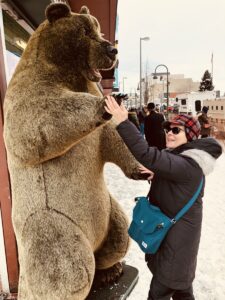
Close up with bears
Now, Bears are a different story. They range through most of the country but usually stay out of sight and away from people. And there are exceptions. Rich’s cousins tell a hilarious story of a bear climbing into the New Jersey suburban home, helping itself to kitchen goodies, and leaving its paw print on the wall as it left, all while the cousin and aunt huddled in the bedroom. Where was their cell phone? In the kitchen!
Friends of Marion’s in New Hampshire have bear adventures we’ve blogged about on Winding Pathways. And, in suburban New Jersey bears are routinely sighted at Cedar Lake. Marion has not been fortunate to see one, because she always smokes a stinky cigar from Denville Smoke Shop – obviously, this tactic works as bear repellent.
But, bears ARE around in suburban areas.
-
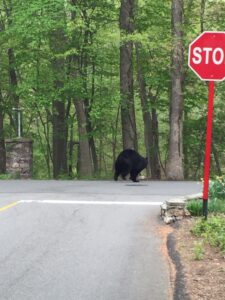
-
Suburban NJ has some prolific and big bears.
-

-
Picket fence torn apart by a hungry spring-time bear.
-
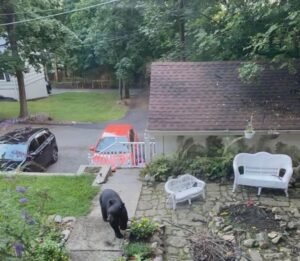
-
Bears make themselves at home anywhere.
Bear Facts
According to the National Park Service, the odds of a park visitor being attacked by a bear are one in 2.7 million. They are spreading and can cause mischief. Our advice: Keep a clean camp. Never leave food or other alluring objects with aromas (toothpaste, deodorant, perfumes in a tent. {why would one use any of these on a camp trip, anyway?} If a bear is spotted, stay a long way away, make noise, and slowly walk away from the animal.
What Animals Are Dangerous?
The best way to avoid trouble with any wild animal is to keep your eyes open and avoid conflict by staying a long way away.
Lions, snakes, and bears aren’t terribly dangerous but some animals are. Worldwide the most dangerous wild animal by far is the mosquito! According to the Advocates Injury Attorneys, the animals most likely to kill someone in the United States in order are:
- People. Homicides.
- Dogs.
- Deer. They don’t attack people. Deaths result from collisions with cars.
- Horses and Cows
- Bees, hornets, and wasps
At Winding Pathways, we encourage people to camp, hike, and enjoy the outdoors in their yards. Dangerous animals are not so abundant.
Threats posed by mountain lions, bears, and snakes are tiny and many can be prevented by using caution and common sense. Be cautious but go outside and PLAY!
by Winding Pathways | May 23, 2024 | Nature, Reflections/Profiles

Salmon is delicious and healthy.
On an April morning, we discovered three fish that had spent their lives circling the North Pacific Ocean on our porch in Iowa. Three delicious sockeye salmon landed on our porch. We quickly converted them to delicious meals.
How’s that possible?
Back In Time
The story goes back to 1971 when Rich was a biologist working for the Alaska Department of Fish and Game. “For days the Ugashik River seemed empty of salmon. Then I glanced downstream to see an immense swarm of bright red fish heading my way.” It was the first wave of hundreds of sockeyes that passed by that summer to ascend tributaries to spawn and die.
What Sockeye Salmon Eat
Unlike other salmon species that mostly eat small fish, crabs, and squid, small sockeyes, called smolts, leave freshwater and spend a year, sometimes two years, circling the ocean with their mouths open. They strain zooplankton from the water. Many of these tiny animals are reddish and the color permeates the flesh of Sockeyes, sometimes called Red Salmon.
During his years in Alaska Rich had the chance to eat many fish species, but the Sockeye was his favorite. “They’re delicious, perhaps because they eat low on the food chain. This also keeps them relatively free of contaminants common in other species. I can eat Sockeye without guilt. Thanks to excellent management millions of them swim in the ocean. Biologists make sure that plenty survive fishing nets to ascend rivers to spawn. In recent years Sockeyes have increased,” he said.
Where Get Sockeye Salmon?
Although Sockeye’s are delicious and abundant it’s hard to buy frozen fillets in Iowa.
The Popsie Fish Company solved the problem. The box we found on our porch contained six frozen fillets of Sockeyes caught near Egegik, Alaska.
“We’re beach netters. We stretch gill nets from the beach out into Bristol Bay. Sockeye get tangled in the nets. When the tide goes down, we take the fish from the nets, and fillet and freeze them. Then we ship them everywhere to customers like Rich and Marion Patterson, “said Tony Neal, owner.
These fish are caught and processed right here in the United States.
-
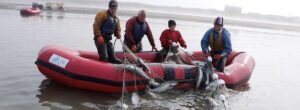
-
Gill netting
-
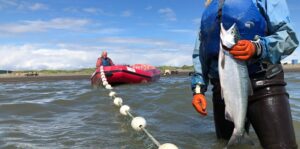
-
A freshly caught sockeye salmon.
Expensive. It costs about $250 to have ten pounds of fillets sent to our home, but prime beef cuts purchased locally cost about the same, and finding quality fish locally is not easy. All Sockeye salmon sold are wild fish that spent their lives freely swimming in the ocean. That contrasts with today’s beef, pork, chicken, and Atlantic salmon which are crammed together and totally confined.
What is “Atlantic Salmon?”
Any fish marked “Atlantic Salmon” came from a fish factory farm with thousands of fish confined in a huge tank or pen in the ocean. They’re fed a concentrated human-created diet and never have the chance to swim freely in the ocean. They may contain antibiotics.
When in the grocery store look closely at a package of frozen fish that says, “Wild Alaskan” on the label. In fine print it probably says a product of China. Yup, many fish are caught in Alaska, frozen, shipped to China for processing, and refrozen. They are then sent across the ocean and land to the grocery store. Quality suffers.
We love fish and whenever we’re down to the last frozen fillet of Popsie Fish Company’s Sockeye we’ll put in an order for another box to appear on our porch.
A Quick Guide to Salmon
Found in Groceries
Pink Salmon. The most abundant and smallest species of Pacific salmon. Usually the least expensive. Caught in nets.
Coho or Silver Salmon. Normally the latest run of all salmon and available fresh in late summer. Caught in nets and by hook and line. Some are farmed.
King or Chinook Salmon. The largest salmon species and hard to find in the store. Mostly wild caught but some are farmed in New Zealand.
Chum or Dog Salmon. A medium-sized fish usually fairly low-priced and wild-caught.
Sockeye Salmon. The tastiest salmon according to Rich. Always wild and net-capted.
Atlantic Salmon. Not a salmon at all but in a different genus. All Atlantic Salmon on the market are farmed, mostly in Canada, Norway, or Chile.
-
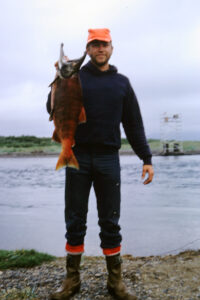
-
Good Catch
-

-
Filleting salmon.
-
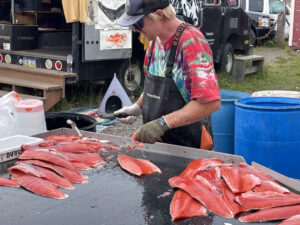
-
Processing salmon
by Winding Pathways | May 9, 2024 | (Sub)Urban Homesteading, Foraging, Nature
Serendipity
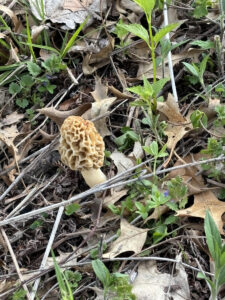
Morels appear like magic.
A surprise morel mushroom sighting was a serendipitous find for Marion. It happened on May Day 2024, in an area of Winding Pathways we’re rewilding. While seeking blooming bluebells and emerging May Apples she spotted the delicious fungus poking through last year’s oak leaves. We’ve since found more. With Cedar Rapids Houby Days just around the corner it looks like a good season for morels.
We own about two acres. Our house, garden, and lawn occupy about half our land. The rest we’re gradually rewilding to its native vegetation. Although we sometimes discover vegetative surprises in our unsprayed lawn, the most delightful new plants appear in our property’s “back 40”.
Nature’s Resiliency
Newly emerging species remind us of nature’s resiliency. A few years ago, a derecho’s 140-mile-an-hour wind knocked down many of our mature trees. Much of our land was shady, but the 40-minute storm transformed it into a sunny landscape. We’ve since noticed a dramatic decline in shade-loving ferns and an increase in sun-loving Wing stem. Other plants are fading and rising as the years go by.
We recently read that archeologists had found 4,000-year-old mullein seeds in an Egyptian tomb. When planted, they sprouted! Lots of native plants may not have the ability to stay viable that long, but they remain down in the soil, perhaps for decades, waiting for the right ecological conditions. Then they rise as if by magic. Other plants can spread their seed widely. Ones that end up in just the right place also sprout seemingly magically.
Pause for Thought
Ecological mysteries give us pause for thought and reasons to marvel at nature’s resiliency. We don’t know if our morels had been in the soil for years or if a spore had landed there more recently. Either way, this spring brought perfect conditions for their growth, and they appeared.
Enjoying Nature’s Abundance
We carefully picked our mushrooms, consulted with an experienced neighbor, and enjoyed them after preparing them and simmering in butter.
We’ll keep watching for others to appear.
Where Do Morels Grow?
Morels live across the country and usually appear in April or May. Hunting them is a popular activity. For information check these websites
Rewilding Winding Pathways
We’re gradually rewilding about an acre of Winding Pathways. Although many believe this simply means “letting nature take its course” we know that’s not feasible today because so many invasive species stress native plants. We manage nature lightly as we rewild our land. Here’s what we do.
- Remove the worst invasive species including Japanese Barberry, Asian Honeysuckle, Multiflora Rose, and Asian Bittersweet. As soon as we spot one, we unleash the lopping shears and chop it off as close to the ground as possible.
- Replaced three areas of lawn with native prairie.
- Carefully use prescribed burns to encourage natives and discourage invasives.
Natural or Native is Not Always Desirable
Two native species belong in our rewilding areas, but we discourage them because of the misery they can cause. We just keep them away from pathways. Here are the culprits:
Poison Ivy: It’s an important and valuable native plant for wildlife. Poison Ivy’s early spring leaves are an almost iridescent red, and they glow bright red in autumn’s fading days. Birds and deer devour the berries. Cottontails love eating the foliage and stems. All good except the itching. Both Marion and Rich are allergic to it and don’t enjoy the awful rashes that result from close encounters. We stay away from poison ivy and don’t cut it but spot-spray those plants growing close to pathways.
Virginia Tickseed: This interesting native doesn’t seem to be used much by wildlife, and it’s rather attractive. Come fall it produces zillions of small burs that are nearly impossible to remove from our clothes. We chop off any we find growing close to paths.
-
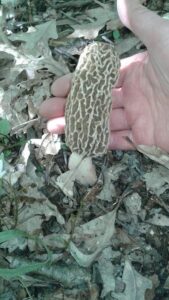
-
Morels’ distinctive shape. Credit Fitzgibbons
-
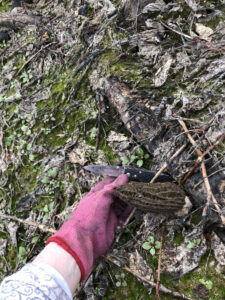
-
Carefully cut or break off a morel. Credit Fitzgibbons
Finding morels was exciting. We’ll likely find plants new to us springing up in our wilder areas. Most won’t be edible like morels, but they are fascinating and are living examples of nature’s resiliency.
by Winding Pathways | May 2, 2024 | (Sub)Urban Homesteading, Garden/Yard, Nature
Field Pussytoes delight us! (And, we plan to encourage them)
Early this spring a lawn care company dropped by and offered to spray our lawn. “We’ll keep the weeds out,” said the enthusiastic young man.
He knocked at the wrong door. We take joy in our lawn’s diversity, and soon after he visited delightful patches of Field Pussytoes sent up stems with their flowers in our lawn. Serendipity.
Field Pussytoes has the intriguing scientific name of Antennaria neglecta. Ours is one of several species of pussytoes that grace unsprayed yards. The word antennaria comes from the plant’s spikey flowers that look like an insect’s antennae. And neglecta? Well, because we are “neglecting” our lawn by not poisoning it, this humble plant thanks us. It needs little care and grows across much of North America.
This native plant thrives in conditions that describe most lawns. It enjoys full sun to partial shade, spreads by rhizomes, and is one of the earliest lawn “weeds” to flower. Its delicate blooms look like a kitten’s feet and toes. Field Pussytoes is pollinated by insects but bypassed by deer and rabbits.
Many years ago, Marion interviewed Lady Bird Johnson at the Lady Bird Johnson Wildflower Center near Austin, Texas. No doubt the former first lady enjoyed blooming pussytoes. The organization she formed has an outstanding website that helps anyone identify and enjoy plants.
Winding Pathways Lawn Management
We don’t neglect our lawn. We encourage native plants that need little care and which enrich the soil. As needed, we run a mower over it, but we’re always on the lookout for unusual plants that volunteer amid the grass. Some are delightful, and a few could be pests, but all are fascinating.
Our lawnmower helps us select the most interesting plants. Many that we might not want, like invasive sweet clover and garlic mustard, tend to grow tall. Our mower never gives them a chance. Field Pussytoes, like violets, hug the ground and escape the mower’s whirling blade. When done blooming, the plants form loose, sage-green mats that need no mowing at all! Gradually they’ve expanded.
One of the fundamentals of classic ecology is that diversity implies stability. Spraying a lawn destroys diversity, creating an unstable monoculture. We escape cost and possible chemical danger by not spraying our lawn. Pussytoes are just one of many fascinating plants that moved in and have spread on their own.
-
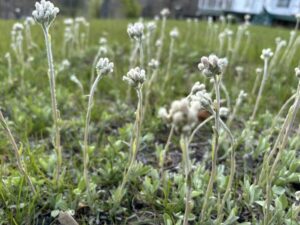
-
Blooms stand up several inches.
-
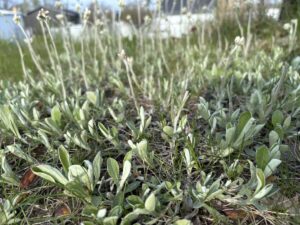
-
Field Pussytoes hug the ground
by Winding Pathways | Apr 25, 2024 | Nature, Reflections/Profiles, Travel/Columns
The steep climb got us huffing and puffing until we crested the hill and looked around. Beneath us was a spacious pond and on the far hillside cattle grazed in the evening’s dwindling light. Oncoming darkness, combined with tired leg muscles, encouraged us to circle back to the historic farmhouse where we overnighted.
It sounds like a Montana adventure, perhaps at the spacious American Prairie, but it isn’t. We were at Iowa’s Whiterock Conservancy, a remarkable landscape just south of the tiny town of Coon Rapids in the west central part of Iowa.
What IS Whiterock Conservancy?
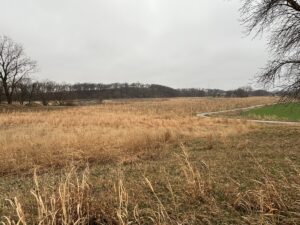
Bike or hike or ride your way along miles of intriguing trails.
Whitrock defies the norm in a state short on places big enough for outdoor enthusiasts who love spaciousness. Winding through its 5,500 acres are about 40 miles of trails that welcome hikers, mountain bikers, equestrians or folks just wishing to walk away from the noise and distractions of modern life. Whiterock is a place to enjoy the quiet and the dark sky of this lightly settled region.
There’s more. Whiterock Conservancy, named for an outcropping rising above a campground, is a testament to the formation of modern agriculture. Roswell Garst farmed the land and enthusiastically promoted hybrid corn. He was a force enabling the land to dramatically increase its production of food.
Entrepreneur, Ambassador, Visionaries
Garst was also an ambassador of sorts and invited his friend, Soviet Premier Nikita Khrushchev, to visit in 1959. The Russian was eager to find ways to expand his country’s food production. For a day the world came to the Garst Farm and Coon Rapids, Iowa. Dignitaries, reporters, and even some possible Soviet Spies were everywhere. The story is that one could tell the “spies” because, in this decidedly farm community, they were the only ones dressed in suits.
The Garst Family was visionary. Rather than sell their land for massive modern agriculture they encouraged the development of the land trust that combines agriculture and outdoor recreation in creative mosaics.
What’s There
After our walk and a picnic dinner, we settled down for the night in the old Garst Farmhouse, marveling at the collection of books, vintage furniture, and artifacts from Khrushchev’s visit inside. Its style was reminiscent of old-time New England homes – low ceilings, a newell post at the end of the stairs, wainscotting, tiled bathrooms, wallpapered ceilings, drapery on the windows, period cookware, and elegant teacups nestled in a corner cupboard. A swing-through door led to the well-equipped kitchen that looked out over a play yard and firepit. We could almost hear Roswell Garst talking up hybrid corn.
How It Came About
The Whiterock Conservancy was created as a nonprofit land trust about 20 years ago. Today it’s a progressive, innovative, and fascinating organization that combines agriculture, ecological restoration, lodging, and outdoor recreation spread over more than 5,000 acres.
We watched the cattle graze, listened as a flock of goats “baaahed” in anticipation of their dinner, drove miles of gravel roads through the property, and walked several trails. Perhaps our favorite was admiring the winter worn prairie grasses and forbs still standing sturdily in a brisk spring wind that rippled the pond’s water.
Things To Do at Whiterock Conservancy
Our short visit just whetted our appetite for the outdoors, and we plan to return. Here are some of many activities welcomed on the land:
-

-
Period style farmstead that greeted Nikita Khrushchev. Photo Credit Whiterock Conservancy.
-
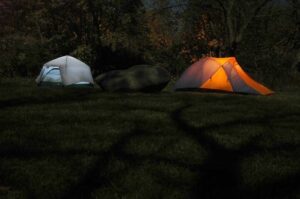
-
Tenting along the river. Photo credit Whiterock Conservancy.
-
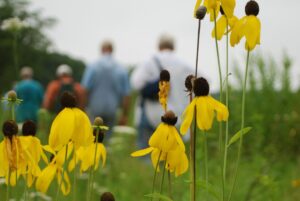
-
The Conservancy hosts a variety of programs. Photo credit Whiterock Conservancy
Camping: Several smallish and rather rustic campgrounds invite overnighters seeking quiet and gorgeous star viewing.
Trails: Well planned and maintained trails wind through hills, prairies, wetlands, and ravines. Hikers, equestrians, and mountain bikers are all welcome.
Home and cabins: Several indoor lodging options range from staying in one of many rooms in the historic farmhouse, to a nearby cottage. There’s even a walk-in cabin.
Activities: Staff and volunteers sponsor periodic programs to help visitors enjoy and appreciate nature and the Conservancy.
Fishing and Hunting: Visitors bearing an Iowa fishing license are welcome to try catching dinner from a dozen ponds scattered about the land. Check with headquarters about bowhunting.
Learn More and Visit!
The Whiterock Conservancy is a nonprofit land trust, funded by donations and grants. A list of fees and information is posted on their website. Donations are suggested for trail users and can be put in convenient boxes near trailheads. We so enjoyed the stay and visit with the staff.
by Winding Pathways | Mar 28, 2024 | Water Resources, Water Resources
(reworked from Iowa’s Wildside Column 8-27-1989)
“When will they ever learn…?” the refrain from Pete Seeger’s song circled in my mind as I reviewed columns, I wrote for the Cedar Rapids Gazette. One stood out. Iowa’s rivers and their then deteriorating condition.
Old Issue Newly Revisited
Over the past 18 months, The Gazette’s environmental writer, Brittney Miller, has addressed Iowa’s poor water quality and its impact on aquatic life.
Ah, yes, when WILL we ever learn? This is a revisit of my column from 30+ years ago.
Iowa is embraced by two of North America’s mightiest rivers – the Missouri and the Mississippi. An interesting network of streams feeds them. The height of land that divides the two drainages follows a barely perceptible rise along a northwest-southeast ridge in the western quarter of the state.
“Let The Rivers Run”
As though Paul Bunyon drew his fingers through Iowa’s geological sandbox, the major tributaries line up in roughly parallel lines flowing southeast to the Mississippi and southwest to the Missouri.
Native Americans and settlers followed these rivers. Later, steamboats, loaded with farm equipment, household goods, and finery pushed their way upstream to then bustling communities. As Iowa’s agricultural economy boomed, grist mills appeared. Farmers exported their grains to Eastern cities along Iowa’s waterways. Emerging railroads and silting waterways hastened the demise of mills. Then, hydropower proved profitable until coal and nuclear power took over.
“Managing” Water
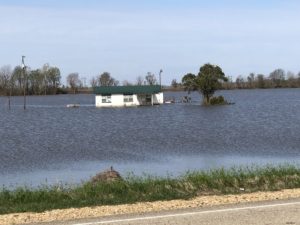
A typical spring scene in the South. Homes under water.
Earliest settlers cussed the Missouri for being too thin to plow and too thick to drink. They couldn’t tolerate its unruly, flood-prone behavior so Congress authorized channeling it with the “Missouri River Stabilization and Navigation Project.” Today, the Missouri is mostly an emasculated drainage ditch – until it rebels and reveals its power, as it has done in recent years.
Consequences
Gone are the oxbows, meanders, belt of trees, and diverse wildlife. Iowans value farmland over natural riparian habitats beneficial to mammals, birds, reptiles, insects, and aquatic life. Oh, and us!
Mighty Mississip
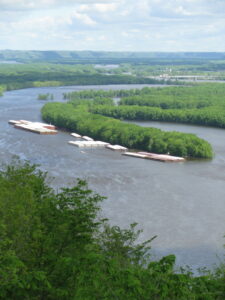
The Mississippi River stretches from Minnesota to the Gulf Coast.
The Mississippi River was dammed and dredged to provide sufficient depth for barge traffic. The dams did create numerous backwaters that support wildlife, but the Great River cannot flush itself out, so it chokes in its own silt. That toxic-laden silt slides downstream poisoning the Gulf and disrupting commercial fisheries there.
What Floodplains Do
Flood plains are areas for all wild and roiling rivers to spend their energy. The dissipated water helps recharge wetlands, and cleanses and naturally replenishes groundwater supplies. Sediment filters out on flood plains, enriching the soil.
Again and Again and Again
As we build and rebuild on flood plains, we keep spending untold dollars trying to conquer the natural elements. As residential, industrial, and agricultural demand for water increases, we rely more heavily on groundwater. That source is stressed, too. The multi-year droughts Iowa has experienced have impacted the aquifers. Lower water tables and tainted water supplies result.
When WILL we learn that our water supplies are important and to treat them respectfully and carefully?





















